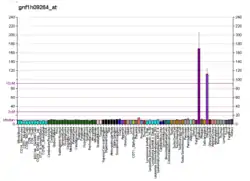| AGR3 | |||||||||||||||||||||||||||||||||||||||||||||||||||
|---|---|---|---|---|---|---|---|---|---|---|---|---|---|---|---|---|---|---|---|---|---|---|---|---|---|---|---|---|---|---|---|---|---|---|---|---|---|---|---|---|---|---|---|---|---|---|---|---|---|---|---|
| |||||||||||||||||||||||||||||||||||||||||||||||||||
| Identifiers | |||||||||||||||||||||||||||||||||||||||||||||||||||
| Aliases | AGR3, AG3, BCMP11, HAG3, PDIA18, hAG-3, AG-3, anterior gradient 3, protein disulphide isomerase family member | ||||||||||||||||||||||||||||||||||||||||||||||||||
| External IDs | OMIM: 609482 MGI: 2685734 HomoloGene: 45551 GeneCards: AGR3 | ||||||||||||||||||||||||||||||||||||||||||||||||||
| |||||||||||||||||||||||||||||||||||||||||||||||||||
| |||||||||||||||||||||||||||||||||||||||||||||||||||
| |||||||||||||||||||||||||||||||||||||||||||||||||||
| |||||||||||||||||||||||||||||||||||||||||||||||||||
| |||||||||||||||||||||||||||||||||||||||||||||||||||
| Wikidata | |||||||||||||||||||||||||||||||||||||||||||||||||||
| |||||||||||||||||||||||||||||||||||||||||||||||||||
Anterior gradient protein 3 homolog is a protein that in humans is encoded by the AGR3 gene.[5][6][7]
References
- 1 2 3 GRCh38: Ensembl release 89: ENSG00000173467 - Ensembl, May 2017
- 1 2 3 GRCm38: Ensembl release 89: ENSMUSG00000036231 - Ensembl, May 2017
- ↑ "Human PubMed Reference:". National Center for Biotechnology Information, U.S. National Library of Medicine.
- ↑ "Mouse PubMed Reference:". National Center for Biotechnology Information, U.S. National Library of Medicine.
- ↑ Fletcher GC, Patel S, Tyson K, Adam PJ, Schenker M, Loader JA, Daviet L, Legrain P, Parekh R, Harris AL, Terrett JA (Feb 2003). "hAG-2 and hAG-3, human homologues of genes involved in differentiation, are associated with oestrogen receptor-positive breast tumours and interact with metastasis gene C4.4a and dystroglycan". British Journal of Cancer. 88 (4): 579–85. doi:10.1038/sj.bjc.6600740. PMC 2377166. PMID 12592373.
- ↑ Adam PJ, Boyd R, Tyson KL, Fletcher GC, Stamps A, Hudson L, Poyser HR, Redpath N, Griffiths M, Steers G, Harris AL, Patel S, Berry J, Loader JA, Townsend RR, Daviet L, Legrain P, Parekh R, Terrett JA (Feb 2003). "Comprehensive proteomic analysis of breast cancer cell membranes reveals unique proteins with potential roles in clinical cancer". The Journal of Biological Chemistry. 278 (8): 6482–9. doi:10.1074/jbc.M210184200. PMID 12477722.
- ↑ "Entrez Gene: AGR3 anterior gradient homolog 3 (Xenopus laevis)".
External links
- Human AGR3 genome location and AGR3 gene details page in the UCSC Genome Browser.
Further reading
- Bonaldo MF, Lennon G, Soares MB (Sep 1996). "Normalization and subtraction: two approaches to facilitate gene discovery". Genome Research. 6 (9): 791–806. doi:10.1101/gr.6.9.791. PMID 8889548.
- Zhang Z, Henzel WJ (Oct 2004). "Signal peptide prediction based on analysis of experimentally verified cleavage sites". Protein Science. 13 (10): 2819–24. doi:10.1110/ps.04682504. PMC 2286551. PMID 15340161.
- Persson S, Rosenquist M, Knoblach B, Khosravi-Far R, Sommarin M, Michalak M (Sep 2005). "Diversity of the protein disulfide isomerase family: identification of breast tumor induced Hag2 and Hag3 as novel members of the protein family". Molecular Phylogenetics and Evolution. 36 (3): 734–40. doi:10.1016/j.ympev.2005.04.002. PMID 15935701.
This article is issued from Wikipedia. The text is licensed under Creative Commons - Attribution - Sharealike. Additional terms may apply for the media files.




